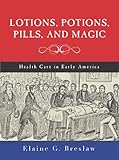Lotions, Potions, Pills, and Magic : Health Care in Early America / Elaine G. Breslaw.
Material type: TextPublisher: New York, NY : New York University Press, [2012]Copyright date: ©2012Description: 1 online resourceContent type:
TextPublisher: New York, NY : New York University Press, [2012]Copyright date: ©2012Description: 1 online resourceContent type: - 9780814787175
- 9780814739389
- Medical care -- History -- 18th century -- United States
- Medical care -- History -- 19th century -- United States
- Medical care -- United States -- History -- 18th century
- Medical care -- United States -- History -- 19th century
- Medicine -- History -- 18th century -- United States
- Medicine -- History -- 19th century -- United States
- Medicine -- United States -- History -- 18th century
- Medicine -- United States -- History -- 19th century
- Physicians -- History -- 18th century -- United States
- Physicians -- History -- 19th century -- United States
- Physicians -- United States -- History -- 18th century
- Physicians -- United States -- History -- 19th century
- Public health -- History -- 18th century -- United States
- Public health -- History -- 19th century -- United States
- Public health -- United States -- History -- 18th century
- Public health -- United States -- History -- 19th century
- HISTORY / General
- 362.10973 23
- R152 .B725 2016
- online - DeGruyter
| Item type | Current library | Call number | URL | Status | Notes | Barcode | |
|---|---|---|---|---|---|---|---|
 eBook
eBook
|
Biblioteca "Angelicum" Pont. Univ. S.Tommaso d'Aquino Nuvola online | online - DeGruyter (Browse shelf(Opens below)) | Online access | Not for loan (Accesso limitato) | Accesso per gli utenti autorizzati / Access for authorized users | (dgr)9780814739389 |
Frontmatter -- Contents -- List of Illustrations -- Acknowledgments -- Introduction -- 1. Columbian Exchange -- 2. Epidemics -- 3. Tools of the Trade -- 4. Abundance -- 5. Wartime -- 6. New Nation -- 7. Giving Birth -- 8. The Face of Madness -- 9. Democratic Medicine -- 10. Public Health -- Conclusion -- Epilogue -- Abbreviations -- Bibliographic Essay -- Index -- About the Author
restricted access online access with authorization star
http://purl.org/coar/access_right/c_16ec
Health in early America was generally good. The food was plentiful, the air and water were clean, and people tended to enjoy strong constitutions as a result of this environment. Practitioners of traditional forms of health care enjoyed high social status, and the cures they offered-from purging to mere palliatives-carried a powerful authority. Consequently, most American doctors felt little need to keep up with Europe’s medical advances relying heavily on their traditional depletion methods. However, in the years following the American Revolution as poverty increased and America’s water and air became more polluted, people grew sicker. Traditional medicine became increasingly ineffective. Instead, Americans sought out both older and newer forms of alternative medicine and people who embraced these methods: midwives, folk healers, Native American shamans, African obeahs and the new botanical and water cure advocates.In this overview of health and healing in early America, Elaine G. Breslaw describes the evolution of public health crises and solutions. Breslaw examines “ethnic borrowings” (of both disease and treatment) of early American medicine and the tension between trained doctors and the lay public. While orthodox medicine never fully lost its authority, Lotions, Potions, Pills, and Magic argues that their ascendance over other healers didn’t begin until the early twentieth century, as germ theory finally migrated from Europe to the United States and American medical education achieved professional standing.
Mode of access: Internet via World Wide Web.
In English.
Description based on online resource; title from PDF title page (publisher's Web site, viewed 06. Mrz 2024)


